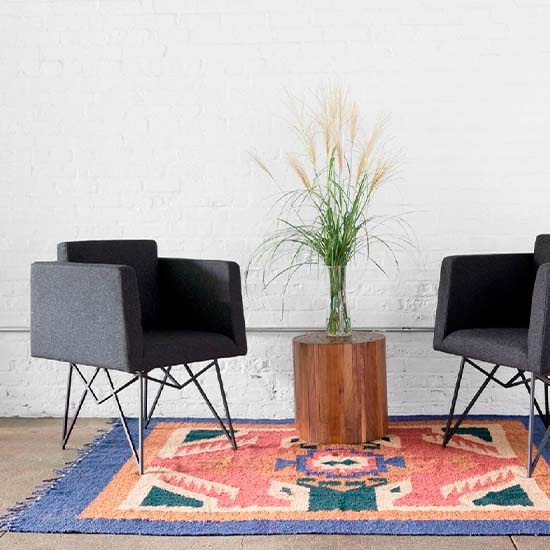“We want CICIL to be as sustainable as possible in every way,” said co-founder Laura Tripp.
Textile industry veterans Caroline Cockerham and Laura Tripp founded home textile company, CICIL, in November of 2021. CICIL offers a variety of braided rugs made from natural, renewable materials– a far cry from a textile industry that emphasizes petroleum-based fibers that negatively impact human health and the planet.
“We wanted to build a brand that reflects all the values we gained throughout our time working for other brands,” says Caroline Cockerham. Thus, CICIL was born, a company that sources and manufactures textiles in small batches, works with farmers directly, and emphasizes supply chain transparency.
CICIL’s Beginnings
Cockerham and Tripp met during their time as material developers at Patagonia, and describe themselves as “textile nerds at heart.” Both went to North Carolina State University, a textile school, and have worked in the industry for brands including Kate Spade, Casper, Best Made, and more.
“We started thinking about CICIL one night several years ago, drinking wine, talking about industry problems we wanted to solve,” said Tripp. “We thought, ‘there are all these fibers available that maybe don’t have a home, or don’t have the right product, so let’s explore the supply chain.’”

Supply chain has remained a pillar of CICIL’s mission since that conversation. “Everything we do is really informed by the supply chain, the capabilities that we can find, and the pieces we can put together… so that’s where the focus on rugs started,” said Tripp.
From there, Cockerham and Tripp started digging into existing supply chains by tapping various contacts they’d made from work at previous companies. They were able to connect with folks already doing impressive work with wool and textiles, including a group in the Hudson Valley that eventually helped provide CICIL’s first run of wool. “It’s kind of amazing. There’s this whole supply chain that you can tap into,” said Tripp. “You just have to dig.”
From there, Cockerham and Tripp were introduced to small family farms all over the Northeast through a contact made from the Hudson Valley group. At present, all of CICIL’s manufacturing is in North Carolina, where the company is based, while all wool is sourced from farmers in New York, Pennsylvania, and Vermont.
Supply Chain Transparency
In founding CICIL, Cockerham and Tripp were able to create a supply chain that uses a coarse wool that often ends up as a waste product. “Our rugs are made from long staple wool that you wouldn’t want to wear in a sweater, because it would be itchy,” said Cockerham. “So often, farmers are like, ‘what do we do with this product?’ We’ve created a supply chain where they have a product that they can sell, make money on, and divert from the landfill.”
Creating a new supply chain was important to the founders because, as Tripp says, “all of the brands that we’ve worked for have manufactured mostly globally… products are shipped all over the world with provenances you may or may not be able to fully trace, almost never back to the farm level.”
When Tripp and Cockerham founded CICIL, they purposely developed products using a traceable, very local supply chain. Between farmers in the Northeast and manufacturers in the Carolinas, their products travel less than 1,000 miles from farm to final product, and benefit each local economy.
Sustainable Processes, Down to the Thread
Traditional rugs can contain up to 47 chemicals, synthetic materials, and finishes that aren’t healthy for us, and end up getting thrown in the landfill after use. “For rugs specifically, and home textiles generally, performance finishes that are supposed to make things stain resistant or wrinkle resistant are really not good for us.” said Tripp. “They’re not something we want to have on our skin, or have our kids rolling around on.” To combat this issue, all of CICIL’s products are made from undyed wool, eliminating the need for toxic finishing, and only use natural materials.
The company doesn’t use any plastic in their packaging either, “a brand risk because it helps keep water out,” says Tripp. “But we just had to stand against that throwaway culture of packaging– and that’s one piece of it.”

When CICIL had an issue where one rug was delivered to a home outside of the box due to an absence of plastic packaging, both Cockerham and Tripp said, “we had to laugh.”
“That was one issue we had by not using plastic packaging… but we just refunded the rug and gave them a new one,” Cockerham added.
Another challenge Cockerham and Tripp have faced is finding sources with enough wool to meet their needs. “Rugs use a lot of wool. Some of our buys are around 20,000 pounds, so you can think about how many different farms a sheerer has to visit to collect that much,” Cockerham said.
Also, because the company doesn’t use dye in the production of their rugs, they need to source from flocks that include dark sheep, a difficulty because dark sheep are “typically bred out,” according to Cockerham.
The Mission Behind the Brand
CICIL’s mission is to create textiles from natural and renewable materials, know where their materials are coming from to begin with, and understand their impact on the earth. “With CICIL, what we’re trying to do is really just explore the textile heritage in our backyard, which we consider the American East,” says Tripp. “And, we want to create a new model for making sustainable products, and share it with others. We want CICIL to be as sustainable as possible in every way.” Cockerham and Tripp acknowledge that they’re constantly learning and evolving their beliefs about how to build products sustainably. CICIL is a reflection of these beliefs put into practice.
"We want CICIL to be as sustainable as possible in every way.”











